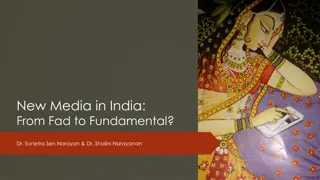The Sexualization of Young Girls in Media: A Critical Analysis
The portrayal of young girls as sexual objects in media and popular culture is a concerning trend that perpetuates harmful stereotypes and behaviors. From the exploitation of adolescent girls in fashion advertising to the normalization of underage sexuality in Hollywood, this issue has deep-rooted implications on society's perception of girls and women. The essay delves into the societal and cultural contexts that contribute to the sexualization of girls, and highlights the need for critical examination of media messages targeting young audiences.
Download Presentation

Please find below an Image/Link to download the presentation.
The content on the website is provided AS IS for your information and personal use only. It may not be sold, licensed, or shared on other websites without obtaining consent from the author.If you encounter any issues during the download, it is possible that the publisher has removed the file from their server.
You are allowed to download the files provided on this website for personal or commercial use, subject to the condition that they are used lawfully. All files are the property of their respective owners.
The content on the website is provided AS IS for your information and personal use only. It may not be sold, licensed, or shared on other websites without obtaining consent from the author.
E N D
Presentation Transcript
https://www.youtube.com/watch?v=Zvnhg1dja1E 2.20 min https://www.youtube.com/watch?v=avTb5yctHvA 3.30 Lolita https://www.youtube.com/watch?v=avTb5yctHvA from 48 min on
Merskin (2004) Repulsive and fascinating mediated portrayals of young girls as inviting and willing participants in their own sexual exploitation The message from advertisers and the mass media to girls (as eventual women) is they should always be sexually available, always have sex on their minds, be willing to be dominated and even sexually aggressed against, and they will be gazed on as sexual objects.
Merskin discusses the sociological and cultural context within which girls are sexualized, explore ideas about the use of adolescent girls bodies in fashion advertising. She applies Galician s (2004) seven-part media analysis framework, and reflect on the potential consequences of sexual images of girls in the advertisements
In contemporary culture, the name Lolita has become synonymous with forbidden lust and love of preadolescent, and by extension, adolescent girls. Looking at sexualized portrayals of girls appropriates them for male consumption
The pornographication of the American girl (Junod, 2001, p. 133) is found in television programs, movies, video games, music videos, magazines, and popular culture.
Hollywood had and has beguiling underage beauties. Mary Pickford, Deanna Durbin, Carroll Baker, Tuesday Weld, Hayley Mills, and Sue Lyon. All were teens when their careers began, became known for portrayals of underage nymphets who enjoyed the attentions of men but made a game of arousing them (Sinclair, 1988, p. 92).
Magazines have a version of the teenage tart in cultivating a climate of acceptability and not only in the advertising contained within them. In an extensive study of images of children, crime, and violence in Playboy, Penthouse, and Hustler magazines, Reisman (1990) found during the period from 1954 to 1984, 6,004 images of children (in cartoons and advertising). The above accounted for 24% of all representations containing children
Throughout the 1980s and 1990s, advertising became the domain of sexual symbolism and seduction Here, adolescent girls are continually marketed as highly sexualized beings, ready to cater to the whims of men (Asher, 2002, p. 23).
Fashion advertising imagery is replete with photographs in which women are dressed down like little girls Conversely, young girls are dressed up as grown women, offering a veritable visual feast based on pedophiliac fantasy (Cortese, 1999).
The strategy behind these advertisements goes beyond the sexualization of adolescent girls but supports an ideology of lower regard and class status for women and children (Goffman, 1976). Ideology is defined as those images, concepts and premises which provide the framework through which we represent, interpret, understand, and make sense of some aspect of social existence (Hall, 2003, p. 89). Althusser (1969) suggested ideology provides a representation of the imaginary relation of individuals to the real condition of existence (p. 233).
https://www.youtube.com/watch?v=avTb5yctHvA 8min Women in the Media (advertisements objectifying and sexualizing women)
Silverblatts (1995) five elements of media literacy : 1. awareness of the impact of the media, 2. recognizing media content as a resource for cultural insight, 3. understanding the process of mass communication, 4. developing strategies to analyze and discuss media messages and as a result, 5. increased enjoyment and appreciation of media content (pp. 2-3). Galician s (2004) model adds 2 more to the 5 above: 6. redesign of media content, discussion of the effects of the message, and 7. steps for change.
In the following section, Galicians seven-step dis- illusioning model is applied to four fashion advertisements to unveil the fa ade of implied sexual innocence DIS-ILLUSIONING GIRL IMAGES IN FASHION ADVERTISEMENTS Step 1: Detection (finding/identifying). Step 2: Description Step 3: Deconstruction Step 4: Diagnosis. Step 5: Design. Step 6: Debriefing. Step 7: Dissemination.
According to Foucault, as described by Lewis (2002), sex is discussed and presented by social institutions to control it, which by extension also can incite and facilitate modes of sexual experience (p. 302). A symbolic reading of adolescent girl bodies in fashion advertisements reveals that what is being procured, offered, and sold is a point of view that supports an ideology that sexualizes girls and infantilizes women to control them and to legitimize that control.
Step 1: Detection (finding/identifying) : Mainstream American print publications ( Vogue, Elle, Cosmopolitan, and The New York Times). Three advertisements display girls positioned and made up to look older (La Perla, Baby Phat, and Gucci) and the fourth is of awoman made to look like a little girl (Marc Jacobs).
Step 2: Description. La Perla is a high-end Italian-based, international lingerie company that has global retail affiliations. In The New York Times (February 12, 2004), the company ran an advertisement featuring a young woman who appears to be a preteen girl. - a blonde girl/woman wearing a pale blue lace demi and matching G-string type bikini panties,leaning against a shadowy cream-colored wall. Her hands reach down and behind her bottom. Her gaze is somnolent and she looks directly at the viewer.
The second advertisement is for Baby Phat, a clothing - young girls are posed, positioned, and prepared in ways that border on pornographic - an African American girl seated on a bright lemon- yellow chair. Her legs are spread eagle across the seat, she is leaning on her right elbow, head turned sidewise revealing her pink glossy lips wrapped around her thumb. She wears a bright emerald green satin jacket that is unzipped to below her cleavage. The jacket is short enough to reveal her bare stomach, and her sky blue silk short shorts (they come to the crease between top of thigh and hip area) are emblazoned with huge emerald green cat eyes, one on each side of her hips, in a way that draws the spectator s eyes to her crotch area. She stares directly at the spectator with a seductive, come-and-get-me kind of look that communicates, When I look like this I always get what I want, and I know it's what you want. Look at me, what are you waiting for?
Step 3: Deconstruction. Sexuality is an essential component of adolescent curiosity and, based on media representations, a clear path to popularity with peers and most importantly, with boys. It is a time of conflicting demands she should appeal to boys, but not too much; appear vampish, but be virginal. While her parts breasts, hips are developing, she is also learning what those parts do, are expected to do, and what behaviors accompany becoming feminine in American society. Thus, she learns to fashion, adopt, and present a false self (Goffman, 1976).
Kate Moss (and all things Calvin)was frequently portrayed as child like and exploitable frolicking in her underpants or lying naked on a sofa. Lederer (1995) pointed out that use of the pseudo-child technique adults dressing and acting like children is standard fare in pornography
Step 4: Diagnosis. Myths are recurring stories that determine a society s perspectives about the world, about themselves, about what behaviors andapproaches have meaning or value beyond the real (Galician, 2004, p. 34). They are the mainstay of media content and communicate a version of reality ortruth. Using images of prepubescent and pubescent girls (or grown womenmade to look that way) in advertising activates and facilitates voyeuristic fantasiesabout what is appropriate, inappropriate, possessable, and safe.
Step 5: Design. What would be a realistic reframing of these advertisements? Girls in advertisements should be portrayed as healthy and realistic ways that have relevance to their lives. If the advertised product or brand is an article of clothing or fashion line, then it logically follows to show that item in a realistic way on realistic-looking examples of the intended target of the advertisement. For example, if the product is a swimsuit, why not show the model swimming?
Step 6: Debriefing. An oppositional reading of these advertisements reveals that what is really for sale goes beyond the product (if the product is even shown in the advertisements). As a site of power, the body is conceived in terms ofbeing inscribed, constituted or rendered meaningful in representation and culture (Lewis, 2002, p. 302). In the Gucci advertisement, for example, themodel s body is displayed in ways that communicate availability and willingness. The body as text is written on in a way that is decipherable through use of sexual referents defined as message elements (visual or verbal) that serve to elicit or educe sexual thoughts (Reichert, 2003, p. 23).
Step 7: Dissemination. This approach to media analysis speaks to the need for knowledge followed by action.























